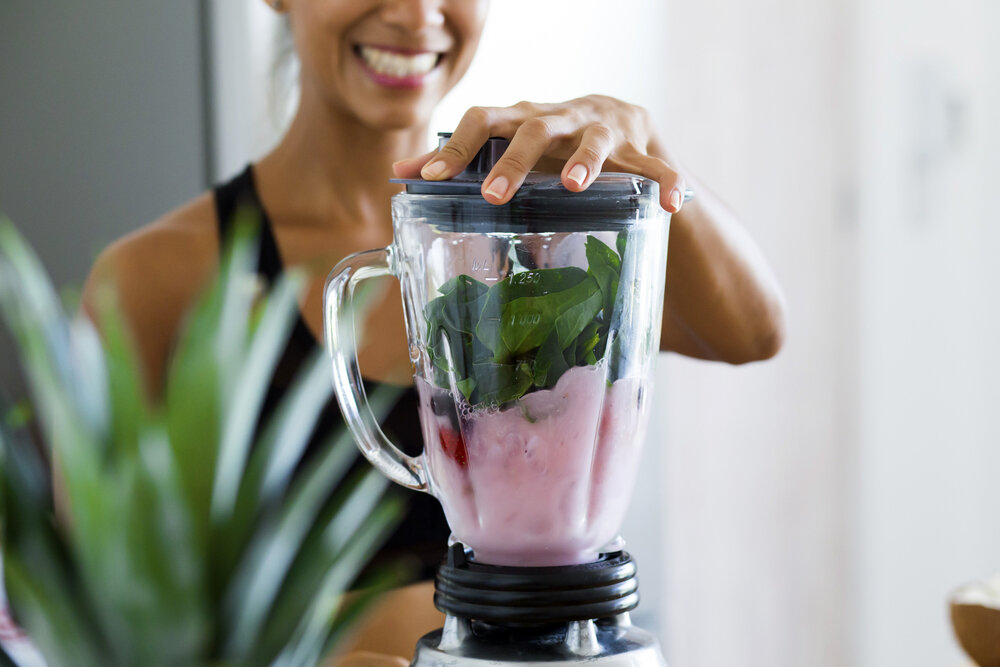Is Blending or Juicing Better?
Is Blending or Juicing Better?
If you’re a picky eater and not a fan of fruits or vegetables, you may find juicing or blending helps you meet your daily recommendations of both. Fruits and vegetables contain vitamins, minerals and phytonutrients that have antioxidant and anti-inflammatory benefits, which are heart healthy, cancer protective and immune supporting. While juicing and blending may seem like the same process, there are some distinct differences.
What is Juicing?
Juicing is a process where the natural liquid of a fruit and/or vegetable is extracted and separated from the solid part, including pulp and skin. This process requires a juicer and provides a very nutrient-dense beverage in a small amount of liquid. Juicing contains very low amounts of fiber since fiber is mostly found in the skin or pulp of fruit and vegetables, the juicing process removes the fiber. For those with irritable bowel syndrome or inflammatory bowel disease, juicing may be a better option due to the low-fiber content. For those with diabetes, juicing may not be ideal since it is quickly digested and could lead to a spike in blood sugar.
Juicing can be expensive and uses a greater volume of produce that yields smaller amounts of a product than when blended. For example, 2 apples, 1 stem of kale, 1 cucumber, 1 stalk broccoli and 1 cup berries would make 1 cup of juice, while with blending that would make 3x as much.
Three basic types of juicing
1. Centrifugal:
Separates the juice from the pulp of fruits/vegetables by using a blade that spins at a very high speed
The speed generates heat and results in a reduction of nutrients
Consume juice within a few hours after juicing before expiration
Quick to use and fairly inexpensive juicer
2. Masticating:
Grinds fruits/vegetables at very low speeds and with no spinning action to produce juice
With lower heat used, more nutrients retained than centrifugal
Slower process to produce juice and may require pre-cutting fruits and vegetables prior to use to prevent clogging
Consume juice within 1-3 days before expiration
Slow juicer and typically more expensive than centrifugal
3. Cold-pressed:
Cold-pressed juice means the fruits/vegetables juices have been extracted using a pressing method hydraulically, using high pressure at low temperatures, to produce juice
Retains the most nutrients during the juicing process in comparison to other juicing techniques
Stores in a refrigerator for 3-5 days with minimal separation, which is longer than other juicing methods
Most expensive type of juicer
What is Blending?
When blending, you are using whole fruits and vegetables including the skin, which means the fiber will be intact and retained. Fiber helps you feel full longer and improves digestive health. The drink a blender produces is usually called a smoothie. Adding nuts, seeds, nut butters and yogurts to smoothies is a great way increase your intake of healthy fats and protein, making your smoothie more nutrient dense. The taste of leafy green vegetables in smoothies will be more masked than in juicing. Blending overall can be more cost effective than juicing since less produce is needed to make a smoothie and yields high nutrients.
Do juices detox or cleanse the body?
Some juices claim to detoxify the body. The body naturally has a detoxification system that removes toxins. Toxins are either made in the body during metabolism producing lactic acid, urea, and waste products, or come from outside the body that may include pesticides, air pollution and chemicals in tobacco products, drugs, or alcohol. Toxins are transformed and excreted through urine, feces, respiration or sweat. Each person’s ability to detoxify varies and is influenced by environment, diet, lifestyle, genetic factors, and health. While juice may help increase urine and fecal output, there is no evidence suggesting it detoxes or cleanses the body.
Smoothie Recipe: Tropical Green
Low-calorie option with adequate carbohydrates and protein
Serving: 1
Serving Size: 16 oz. smoothie
5 oz. vanilla Greek yogurt
1 cup frozen pineapple
1/2 frozen banana
1 cup fresh spinach
1 cup water
*For a thicker consistency, add ice
*To add healthy fats, try 1 Tbsp. chia seeds or flaxseeds
Nutrition Facts: 228 kcal, 0 g fat, 41 g carb, 16 g protein
*Varies based on brand and/or flavors

